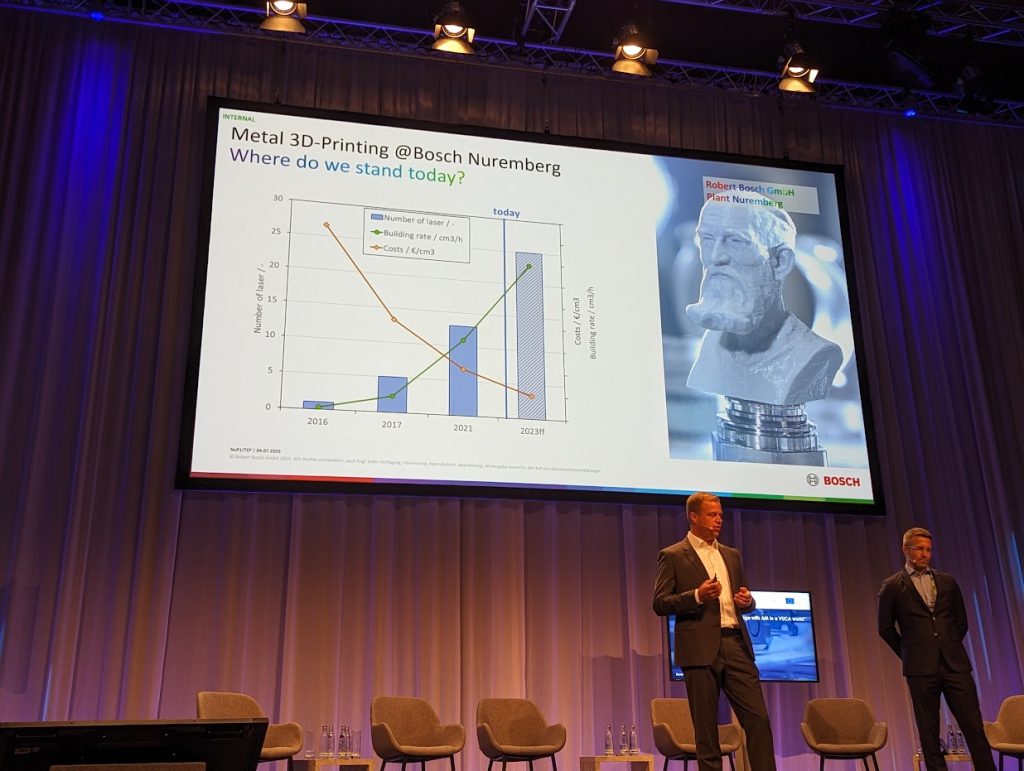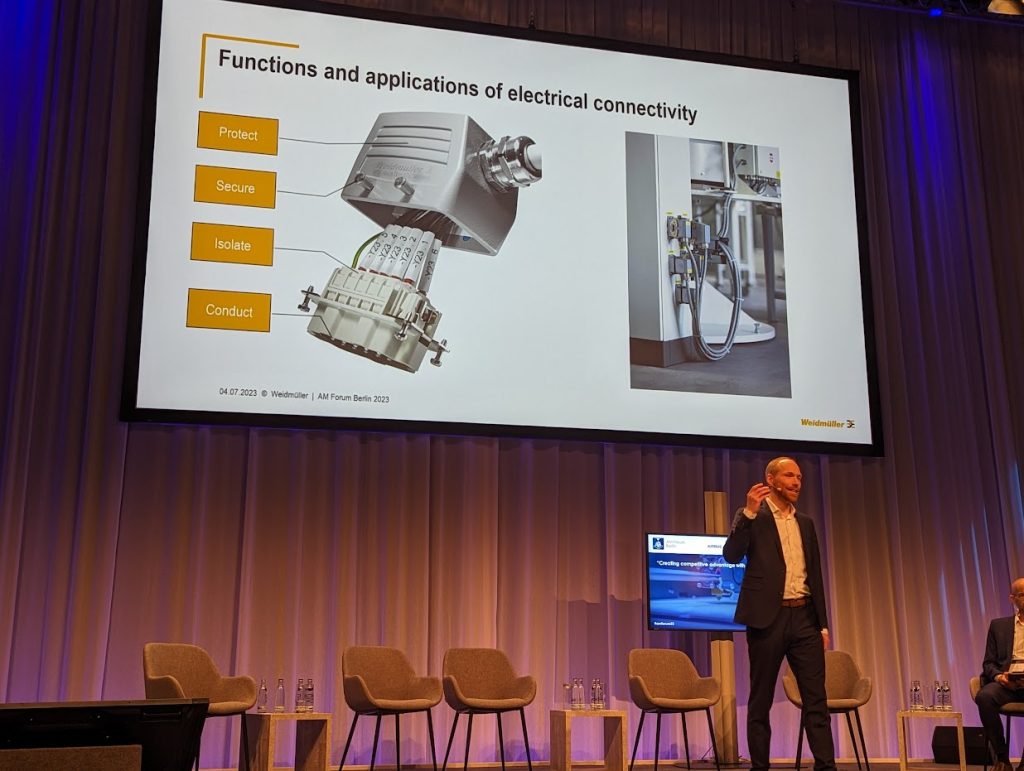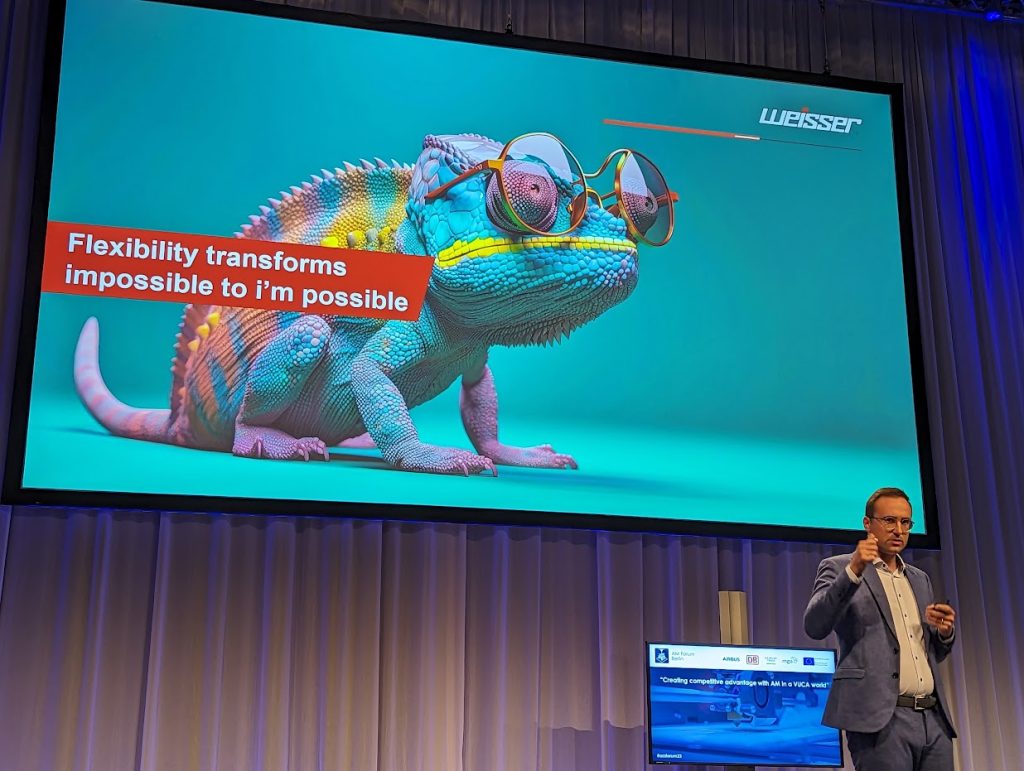AM Forum Berlin 2023 had the overarching theme of Additive Manufacturing in a VUCA world. What is a VUCA world, you might ask? It’s one characterized by volatility, uncertainty, complexity, and ambiguity.
A range of speakers tackled the question of how industrial 3D printing can provide a competitive edge, from cutting-edge AM systems providers to a company with over 170 years of manufacturing experience.
Partnerships are at the core of this approach, and AM Forum Berlin 2023 illustrated this point by inviting 3D printing leaders to share the stage with enterprises putting additive manufacturing to work. SLM Solutions CEO Sam O’Leary encapsulated the approach, stating, “If you don’t partner or you don’t enable integration, what you’re left with is a really cool, isolated piece of technology.”
This article, from our series of insights from AM Forum Berlin 2023, looks at several such ventures and how additive manufacturing can be used with more traditional methods.
Read more from AM Forum Berlin here.
SLM Solutions and additive manufacturing at Bosch
Amidst the rising tide of technological advancement, adopting 3D printing as a key competitive advantage in the industry is no longer a novelty but a necessity. This premise was underlined when AM Forum Berlin 2023 moderator Sven Krause of SK Consulting invited two industry veterans to discuss their collaborative efforts in driving this change. The duo comprised Dr. Kai Kuhlmann, Director of Technical Director Technical Functions, Powertrain Solutions, Robert Bosch, and Sam O’Leary, CEO of SLM Solutions.
Bosch’s foray into additive manufacturing should hardly be a surprise. Yet, their productive alliance with SLM Solutions, a renowned developer and enabler of technology, has rendered the most profound impact.
Opening the conversation, O’Leary declared that the mission of SLM Solutions was to “change the future of manufacturing forever.” More than mere rhetoric, he argued that this transformation is feasible only through “deep-rooted partnerships, partnerships that foster innovation, remove barriers, and quite simply partnerships that just deliver.”
SLM’s task is to empower industrial change. “Our purpose is to deliver what is needed to enable this industrial transformation,” explained O’Leary. This translates as constant pursuit of cost reduction, uncompromised quality, and superior performance.
However, O’Leary cautioned that the finest technology and exemplary use cases are merely a part of the equation. The key catalyst, he proposed, lies in a deeper shift: robust alliances facilitating a symbiotic future.
Fittingly, SLM’s partnership with Bosch is a testament to this integrated approach. The alliance emphasizes integrating SLM’s technology into existing, well-established production processes, aligning with their goal of comprehensive industrial production. The collaboration also signifies a growing industry-wide recognition that additive manufacturing isn’t merely desirable but an essential solution to global manufacturing challenges.
In the sprawling ecosystem of Bosch, with over 400,000 associates worldwide, the Powertrain Solutions division forms a robust part of the mobility solutions business sector. Nuremberg is a hub for additive manufacturing at Bosch, and Dr. Kuhlmann painted a picture of a growing and efficient operation. Over the last decade, this site has become home to five metal 3D printing machines. The Nuremberg site, he claims, is no mere printing facility. It oversees the entire process chain, from 3D printing to machining and milling, including heat treatment.
Handling internal applications across Bosch, the division completes over 300 projects annually, producing more than 2000 parts, some in small series of more than 200. As Dr. Kuhlmann emphasized, the trajectory is one of constant growth and productivity increase, balanced by cost reduction.
However, Bosch’s success is not without its challenges. A key issue could be characterized as a catch-22 situation – the need for new machines to generate business versus the requirement for businesses to invest in new machines. This standoff needs a breakthrough, a different approach to utilize additive manufacturing, not as an alternative but as a decisive advantage, to improve product performance and control costs.
For Bosch, the shift from technology-driven to product-focused is a significant leap. The spotlight is no longer merely on the fast, flexible nature of AM technology but on the advantages this can offer to the products. The new mindset has shown promising results, especially with the importance of quality in the automotive industry. Bosch cannot afford to test each with the volume of parts produced. This predicament has emphasized reliable and reproducible processes and the need to understand whether a part is good or bad at the end of production.
To ensure quality, the Nuremberg team has been sharing the advantages of the technology within Bosch, building up know-how, and sharing success stories. As Dr. Kuhlmann pointed out, fulfilling automotive expectations concerning quality and cost control requires more than just producing the right products. It also necessitates an understanding of shopfloor organization and the increasing role of automation.
Bosch’s journey started small, but it is set to get big. Dr. Kuhlmann’s current estimation suggests that older-generation machines will continue to drive pseudo-production – an interim stage between prototyping and mass production. However, Bosch must transition to highly productive, cost-effective machines, such as the next-gen SLM offerings, to reach the last stage- serial production.
Dr. Kuhlmann stressed the importance of strategic partnerships in this endeavor, hinting at a deep alliance with SLM Solutions. Such collaborations, he implied, will provide the key to unlock the next stage of Bosch’s AM journey, to increase productivity, control processes, and meet both internal and customer expectations.
Despite the challenges, Dr. Kuhlmann is confident that additive manufacturing will be a game changer for Bosch. Expecting growing volume, competitive prices, and reliable processes makes him positive about the future. Leveraging AM design, he argues, will provide a decisive competitive advantage in product performance and unit cost.
“Product performance is key to crossing the chasm,” Dr. Kuhlmann said, indicating a watershed moment in the company’s additive manufacturing journey and referencing a concept introduced by Geoffrey Moore, representing the leap from early adoption to the mass market.

Reducing production costs with 3D printing: insights from the electrical connector industry
Reducing production costs while maintaining product integrity is an increasingly pressing issue within the 3D printing industry. “Innovation is about more than just the manufacturing process; it also encompasses the challenge of adhering to established industry standards and certifications,” noted Dr. Simon Althoff, Head of the Smart Connectivity Competence Center at Weidmüller Interface, during an AM Forum 2023 keynote address on reducing production costs in the electrical connector industry.
For context, electrical connectors — essentially, devices that transmit electricity from a source to a device — are used extensively in various sectors. Their manufacturing is a billion-euro industry, with a few other companies producing similar electrical connectors and cabinet products. The connectors serve four core functions: protecting, securing, isolating, and conducting electricity. They must be resilient against elements such as water and dust, robust enough to remain in place and have the right insulation for safety and functionality.
During his presentation, Dr. Althoff underscored the dual role of the electrical connector industry: not just selling a product but also “the honor of the certificates.” Industry norms, standardizations, and certifications play a crucial role, but they can also create tension with the agility of 3D printing. “It’s a trust issue,” Dr. Althoff observed. “Additive manufacturing is a proper and valuable production technology, but our customers are not just buying a product. They are buying the product with the certificates.”
Despite its benefits, additive manufacturing, as Dr. Althoff pointed out, struggles to navigate an intricate landscape of certifications and industry standards. The extensive certification tests represent a significant cost. Flammability tests, for instance, are essential to ensure that components do not turn cabinets into proverbial fireplaces. For this, AM has provided solutions in flame-retardant plastic parts.

How to scale 3D printing?
In the adoption of industrial 3D printing, there is a nuanced balance to be struck between technology and tradition. Additive manufacturing offers a transformative approach to producing items such as electrical connectors, including low-run products that would traditionally be uneconomical due to the extensive manual labor involved.
“We have automated injection molding machines which are producing 24/7,” Dr. Althoff explained, “we also have lower-run products. For 300-400 connectors, we cannot make [with injection molding], but the customer expects it. Therefore, we are looking to additive manufacturing as a solution for our low-run products.”
3D printing could alleviate the pain points of manufacturing niche components, cutting time and costs while delivering the requisite quality and standards for industrial-grade products.
However, the transition to additive manufacturing isn’t entirely without obstacles. According to Dr. Althoff, the industry’s particular challenge lies in post-processing. “We have the technology and machines available; we have serious production also available,” he acknowledged. “But in the end, we lack industrial post-processing.”
And then there’s the matter of certification. Products manufactured this way must meet strict standards and regulations, the ‘golden’ benchmark being a UL certificate. And herein lies the crux of the issue. As Dr. Althoff put it, “It’s a trust issue.”
Enter Dr. Starnecker, CEO of Weisser Spulenkörper, an injection molding company eagerly exploring the possibilities of additive manufacturing. They can produce at lower costs than plastic injection molding for volumes of less than 10,000 pieces and less than one cubic centimeter.
As Dr. Starnecker emphasized, this flexibility is “the fourth dimension in the production.” That encompasses freedom of design, the ability to iterate more quickly during the development phase, and variability in the quantity of produced parts.
Notably, Weisser Spulenkörper is already producing high-quality functional parts using additive manufacturing. The focus is on “at least as good as the traditional model,” but there’s an ambition for more, a significant step toward “industrial additive manufacturing.”

A shift in injection molding
Dr. Starnecker explains that a shift in the injection molding industry’s norms is underway. Costs ranging from €50,000 to €300,000 pose significant barriers for manufacturers, especially when the market reception for a new product is uncertain. The fundamental disruption – the ability to produce, test, and introduce new products to the market with limited financial risk – exemplifies the promise of additive manufacturing. “[Customers] don’t even know if the market will pick it up. They have an idea that it might pick up, and they say okay, we produce it additively… and the moment the market picks it up, we are happy because we can produce more parts,” Dr. Starnecker elaborates.
Dr. Starnecker identifies a niche where additive manufacturing could excel, not producing millions of identical items, but in “those 600 products where you only have a quantity less than 10,000 parts per year.” This sweet spot, where customization and low volume can coexist economically, could also significantly reduce storage costs and capital tied up in molds.
Furthermore, the technology’s promise extends beyond simple cost savings. Each of the “10,000 parts” could be a unique item, offering unparalleled product customization and complexity.
Dr. Starnecker emphasizes that building trust in additive manufacturing and establishing it as a reliable, repeatable industrial process is critical. If such trust can be fostered, he believes additive manufacturing can answer sustainability and economic challenges. “We need more trust in the community and the industry,” before concluding with a rallying call to “leave the playground and get serious!”
AM Forum returns to Berlin in 2024. More information is available here.
What does the future of 3D printing for the next ten years hold?
What engineering challenges will need to be tackled in the additive manufacturing sector in the coming decade?
To stay up to date with the latest 3D printing news, don’t forget to subscribe to the 3D Printing Industry newsletter, follow us on Twitter, or like our page on Facebook.
While you’re here, why not subscribe to our Youtube channel? Featuring discussion, debriefs, video shorts, and webinar replays.
Are you looking for a job in the additive manufacturing industry? Visit 3D Printing Jobs for a selection of roles in the industry.
Featured image shows Sam O’Leary, SLM Solutions, [R] and Dr. Kai Kuhlmann of Robert Bosch. Photo via AM Forum Berlin.



